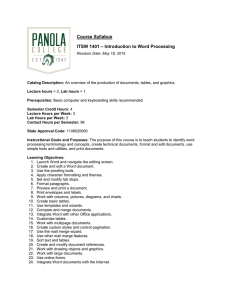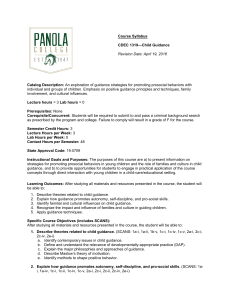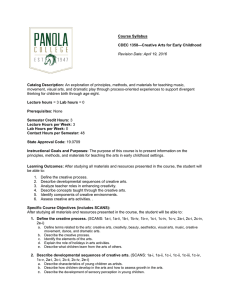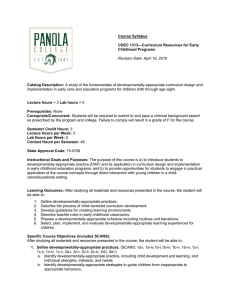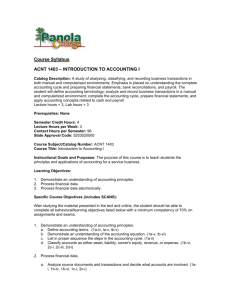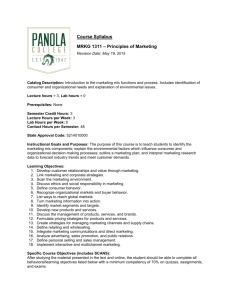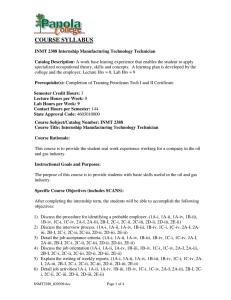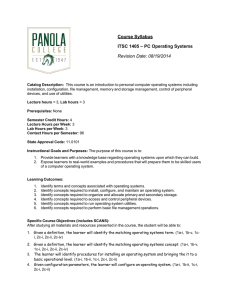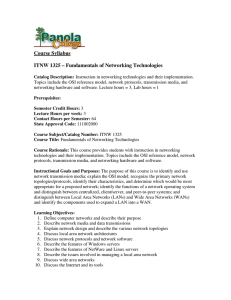Course Syllabus – Word Processing POFI 2401
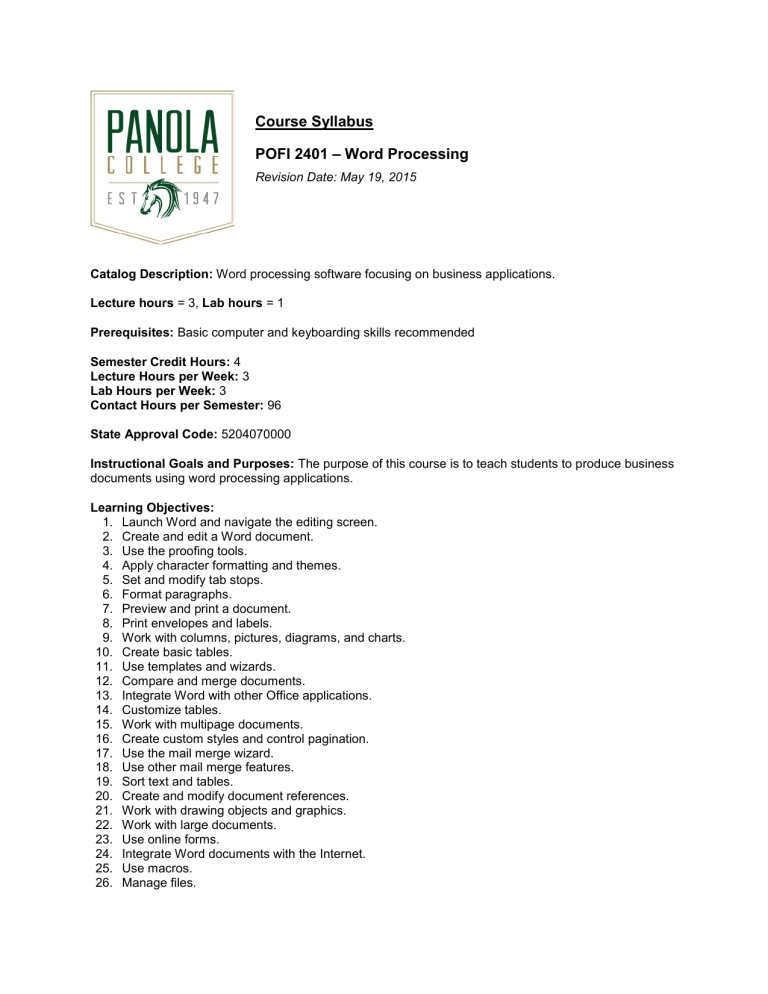
Course Syllabus
POFI 2401 – Word Processing
Revision Date: May 19, 2015
Catalog Description: Word processing software focusing on business applications.
Lecture hours = 3, Lab hours = 1
Prerequisites: Basic computer and keyboarding skills recommended
Semester Credit Hours: 4
Lecture Hours per Week: 3
Lab Hours per Week: 3
Contact Hours per Semester: 96
State Approval Code: 5204070000
Instructional Goals and Purposes: The purpose of this course is to teach students to produce business documents using word processing applications.
Learning Objectives:
1. Launch Word and navigate the editing screen.
2. Create and edit a Word document.
3. Use the proofing tools.
4. Apply character formatting and themes.
5. Set and modify tab stops.
6. Format paragraphs.
7. Preview and print a document.
8. Print envelopes and labels.
9. Work with columns, pictures, diagrams, and charts.
10. Create basic tables.
11. Use templates and wizards.
12. Compare and merge documents.
13. Integrate Word with other Office applications.
14. Customize tables.
15. Work with multipage documents.
16. Create custom styles and control pagination.
17. Use the mail merge wizard.
18. Use other mail merge features.
19. Sort text and tables.
20. Create and modify document references.
21. Work with drawing objects and graphics.
22. Work with large documents.
23. Use online forms.
24. Integrate Word documents with the Internet.
25. Use macros.
26. Manage files.
Specific Course Objectives (includes SCANS):
After studying the material presented in the text and online, the student should be able to complete all behavioral/learning objectives listed below with a minimum competency of 70% on assignments and exams.
1. Launch Word and navigate the editing screen . (1a-i, 1a-iv, 1b-iv, 1b-vi, 1c-iv, 2c-i, 2c-ii, 2c-iii,
2c-iv) a. Launch Word. b. Identify the components of the Word window. c. Edit a document. d. Save a document. e. Preview and print a document. f. Close a document. g. Locate and open an existing document. h. Create a new document. i. Close the Word application.
2. Create and edit a Word document . (1a-i, 1a-ii, 1a-iv, 1b-iv, 1b-v, 2c-i, 2c-ii, 2c-iii, 2c-iv) a. Create a letter. b. Select text. c. Cut, copy, and paste text. d. Switch between editing views.
3. Use the proofing tools . (1a-i, 1a-iv, 1b-i, 1b-iii, 1b-iv, 1b-vi, 2c-i, 2c-ii, 2c-iii, 2c-iv, 2d-iii) a. Check spelling and grammar. b. Use synonyms and the thesaurus to replace words. c. Use the AutoCorrect tool. d. Insert text with the AutoCorrect tool. e. Find and replace text.
4. Apply character formatting . (1a-i, 1a-iv, 1b-iii, 1b-iv, 2c-ii, 2c-iii, 2c-iv) a. Change fonts and font sizes. b. Apply font styles, character styles, and special character effects. c. Change the case of text. d. Highlight text in a document. e. Insert symbols and special characters.
5. Set and modify tab stops . (1a-i, 1a-iv, 1b-ii, 1b-iii, 1b-iv, 1b-vi, 2c-ii) a. Set left tab stops. b. Set center tab stops. c. Set decimal tab stops. d. Set right tab stops. e. Set tab stops with leaders.
6. Format paragraphs . (1a-i, 1a-iv, 1b-iv, 2c-ii) a. Add bullets, numbering, borders, and shading. b. Set line and paragraph spacing. c. Align and indent paragraphs. d. Insert page breaks. e. Create and modify headers and footers. f. Apply paragraph styles. g. Create outlines.
7. Preview and print a document . (1a-i, 1a-ii, 2c-iii, 2c-iv) a. Use Print Preview. b. Print a document.
8. Print envelopes and labels . (1a-i, 1a-ii, 1a-iv, 2c-i, 2c-ii, 2c-iii, 2c-iv) a. Print envelopes. b. Print labels.
9. Work with columns, pictures, diagrams, and charts . (1a-i, 1a-iv, 1b-iv, 2c-ii, 2c-iv) a. Create and use newspaper columns.
2
b. Insert pictures. c. Create diagrams. d. Create and modify a data chart.
10. Create basic tables . (1a-i, 1a-iv, 1b-iv, 2c-ii, 2c-iv) a. Create and format tables. b. Modify tables. c. Position tables. d. Apply AutoFormats to tables.
11. Use templates and wizards . (1a-i, 1a-iv, 1b-iv, 1b-v, 1b-vi, 2c-ii, 2c-iv) a. Create a document using a template. b. Create a custom template. c. Create a document using a wizard.
12. Compare and merge documents . (1a-i, 1a-iv, 1b-iii, 1b-iv, 2c-i, 2c-ii, 2c-iii, 2c-iv) a. Track changes to a document. b. View and edit comments. c. Compare and merge documents. d. Convert documents into web pages.
13. Integrate Word with other Office applications . (1a-i, 1a-iv, 1b-ii, 1b-iii, 1b-iv, 1b-vi, 2c-i, 2c-ii,
2c-iii, 2c-iv) a. Use Excel data in a Word document. b. Share data with PowerPoint. c. Use Access tables or queries in a Word document. d. Create and modify charts using data from other applications.
14. Customize tables . (1a-i, 1a-iii, 1a-iv, 1b-iv, 2c-i, 2c-ii, 2c-iii, 2c-iv) a. Use special table features. b. Perform calculations in a table. c. Use table styles. d. Use tab stops in a table. e. Convert text to a table. f. Merge and split table cells.
15. Work with multipage documents . (1a-i, 1a-iv, 1b-iii, 1b-iv, 2c-i, 2c-ii, 2c-iii, 2c-iv) a. Navigate with the Select Browse Object. b. Verify paragraph formats using the Reveal Formatting task pane. c. Create sections with different formatting. d. Create different headers and footers in a document. e. Use hyphenation.
16. Create custom styles and control pagination . (1a-i, 1a-iv, 1b-iv, 2c-ii) a. Create and apply styles. b. Control pagination.
17. Use the mail merge wizard . (1a-i, 1a-ii, 1a-iv, 1b-iii, 1b-iv, 1b-vi, 2c-i, 2c-ii, 2c-iii, 2c-iv) a. Explain the steps of the mail merge process. b. Define the main document. c. Select the data source. d. Merge the main document and data source.
18. Use other mail merge features . (1a-i, 1a-ii, 1a-iv, 1b-iii, 1b-vi, 2c-i, 2c-ii, 2c-iii, 2c-iv) a. Create multiple envelopes. b. Generate labels. c. Create directories. d. Modify an existing Word table data source. e. Query data records. f. Insert Word fields.
19. Sort text and tables . (1a-i, 1a-iv, 1b-iv, 2c-ii, 2c-iv) a. Sort dates. b. Sort lists. c. Sort paragraphs. d. Sort tables.
3
20. Create and modify document references . (1a-i, 1a-iv, 1b-iii, 1b-iv, 1b-vi, 2c-ii, 2c-iii, 2c-iv) a. Insert bookmarks. b. Create and modify footnotes and endnotes. c. Create a cross-reference. d. Create and modify a table of contents. e. Create and modify an index. f. Use the document map.
21. Work with drawing objects and graphics . (1a-i, 1a-iii, 1a-iv, 1b-iv, 1b-vi, 2c-i, 2c-ii, 2c-iii, 2c-iv) a. Create drawing objects. b. Add decorative page borders. c. Use WordArt special text effects. d. Insert, position, and delete pictures. e. Insert and edit text boxes. f. Create and edit an organization chart. g. Create an equation.
22. Work with large documents . (1a-i, 1a-iv, 1b-iv, 2c-ii, 2c-iv) a. Create master documents and subdocuments. b. Create multiple versions of a document. c. Automatically format an entire document. d. Automatically summarize a document.
23. Use online forms . (1a-i, 1a-iv, 1b-iv, 1b-vi, 2c-i, 2c-ii, 2c-iii, 2c-iv) a. Create and modify an online form. b. Create a document based on a form template.
24. Integrate Word documents with the Internet . (1a-i, 1a-ii, 1a-iv, 2c-i, 2c-ii, 2c-iii, 2c-iv) a. Create a web page. b. Send email messages from Word. c. Distribute documents for revision. d. Use digital signatures.
25. Use macros . (1a-i, 1a-iv, 2c-ii, 2c-iv) a. Record and run macros. b. Edit macros. c. Copy, rename, and delete macros.
26. Manage files . (1a-i, 1a-iv, 2c-i, 2c-ii) a. Search for specific files. b. View and modify file properties. c. Protect documents. d. Define the default file location for workgroup templates. e. Customize toolbars and menus.
Course Content:
Students in all sections of Word Processing will be required to do the following:
1. Students will submit an assignment each week. Each assignment stresses features and functions common to word processors including creation of documents, formatting, setting tabs, creating tables, working with columns, mail merge, etc.
2. Students will assemble a portfolio of work to be submitted at the end of the semester.
3. Students will complete three hands-on, application exams using a word processor in the presence of a testing proctor.
Methods of Instruction/Course Format/Delivery:
Students in both the traditional class and in the Internet class will have access to this course via Canvas.
Students in the traditional class will meet regularly for lecture over the material. Students in the Internet class will only be required to meet with the instructor for testing; however, Internet students are always welcome to attend the traditional class (especially for exam reviews).
All assignments will be submitted through Canvas. After the assignment has been graded, the student will be able to view his or her grade by returning to the assignment or by clicking the Grades link in the left
4
banner. All exams will be hands-on application tests and students will not be able to view the answers to the exams online; however, they will be able to see their grade in Grades and drop by the office to review their exams. Work is generally graded and posted within two days following the deadline.
Students in both the traditional and Internet classes should use email within Canvas to communicate with the instructor. Using Canvas email gives you access to the instructor and other classmates without having to remember or type email addresses —you just select a name from the list. If you are not able to contact your instructor using email in Canvas, you may use his or her Panola College email address. Panola
College instructors attempt to respond to all email within 24 hours. Please always include a subject line and your name in your email.
Assessment:
The following items will be assigned during the semester and used to calculate the student’s final grade:
ASSIGNMENTS
Students will work through each of the projects in the textbook. At the end of each project, there will be an assignment —either the Apply Your Knowledge or In the Lab exercises. Generally, only one or two exercises will be assigned at the end of a chapter —you are only responsible for completing the exercises assigned. Always check the Assignments link to make sure which exercises are required. These documents will be submitted through the assignment itself and will be graded and returned to you in the same manner. Homework is due as assigned and 10 points will be deducted for each day work is late. I do not take late work after homework has been graded and returned to the class. Remember: If you are having trouble with your computer or
Canvas, there are other ways to get your documents to me on time —even if you have to deliver it to me in person. Submission of someone else’s work will receive a zero.
PORTFOLIO
Each project in your textbook contains step-by-step instructions for learning specific Word functions. Within each chapter, you will be asked to print a hard copy of your work —you should place these printouts in your portfolio. Check the Assignments link to verify which pages of each project are being assigned. The portfolio itself should be a lightweight notebook —no three-ring binders please. The documents should be bound and assembled in the order they were printed. It is your responsibility to keep up with these documents throughout the semester. A list of items that must be in your portfolio and a due date can be found by clicking the Assignments link. The portfolio must be submitted in person or by mail before the due date listed on the assignment.
Portfolios are due by the scheduled deadline and 10 points will be deducted for each day work is late.
EXAMS
All exams will be application tests where you demonstrate what you have learned using a computer in one of Panola College’s labs. Internet students will need to make an appointment with the appropriate testing center to take the exams on the Carthage, Marshall, or Shelby
College campuses. Students taking this course through the Virtual College of Texas (VCT) will need to make testing arrangements with the testing center at their colleges before each exam.
The Calendar will list the times testing will be available. Deductions on assignments and tests will occur for minor and major formatting errors, as well as, typographical errors.
Course Grade:
The grading scale for this course is as follows:
Assignments – 30%
Portfolio – 20%
Exams – 50%
All of your grades including a mid-semester and final grade will be posted to Grades in Canvas.
5
Cheating is defined as unauthorized help on an examination or assigned course material. A student must not submit another student’s work as his or her own. A student must not receive from any other student or give to any other student any information, answers, or help during an exam. A student must not "steal" the answers from an unsuspecting student during an exam. A student must not use any sources for answers during an exam (including but not limited to notes, books, or electronic devices) without prior authorization from the professor. A student must not obtain exam questions illegally, tamper with the exam questions, nor change the results of an exam after it has been graded. All cheating infractions will result in a grade of “0” for the assignment.
Plagiarism is defined as the taking of a person's ideas, words, or information and claiming those properties as one's own. The use of all ideas, words, or information from any source must be properly referenced and due credit must be given to its author. All written assignments must be submitted through
Canvas which uses turnitin.com to calculate percent originality of the submission. For compositions, a student’s work must show 0% plagiarism. For research assignments, properly quoting and citing information from other sources is usually required in the assignment; however, since the integrity of the assignment is based upon the originality of the student's work, no student may turn in a paper which exceeds a 30% score in properly quoted and cited material. The instructor reserves the right to employ other means outside of turnitin.com to check the "originality" of a students work. Any submission that contains copied material (other than cited material in a research paper) will automatically receive a grade of "0" for the assignment.
A student will fail the class upon his or her second cheating and/or plagiarism offense. These policies shall be adhered to unless mitigating circumstances should prove a lesser penalty should apply.
Students shall have the right to contest a cheating or plagiarism claim; the appeals process is specifically defined in the student handbook.
Attendance:
Students in the face-to-face class are expected to arrive on time and remain in class until the class is over as random movement into, out of, or around the classroom is disruptive and disrespectful. Students are highly encouraged to participate in class by asking questions and engaging in discussions. Disruptive class behavior will result in dismissal from the classroom and an absent mark on the attendance record.
Persistent, disruptive behavior may ultimately result in dismissal from the course, a failing grade, and further disciplinary actions in accordance with college policy.
Make up assignments/exams will only be granted in accord with the excused absence policy.
A student that chooses to NOT finish the course must complete the withdrawal procedure in the Student
Success office in order to receive a “W.” Otherwise, the student will receive a grade at the end of the semester commensurate with the work completed.
Students needing special classroom or testing accommodations because of physical or learning disabilities must contact the Student Success office before these services will be made available in the classroom.
Texts, Materials, and Supplies:
Microsoft Word 2013: Comprehensive , Enhanced Edition, Vermaat, Cengage Learning, 2016,
ISBN: 9781305507210.
Access to a computer and the Internet.
Access to Microsoft Office 2013 (Word, Excel, Access, PowerPoint).
Flash drive (if you want to save to an external drive).
Student data files that must be downloaded from the publisher ’s site or obtained from instructor.
Other:
For current texts and materials, use the following link to access bookstore listings: http://www.panolacollegestore.com
.
For testing services, use the following link: http://www.panola.edu/elearning/testing.html
.
If any student in this class has special classroom or testing needs because of a physical learning or emotional condition, please contact the ADA Student Coordinator in Support Services located
6
in the Administration Building or go to http://www.panola.edu/student-success/disability-supportservices/ for more information.
Withdrawing from a course is the student’s responsibility. Students who do not attend class and who do not withdraw will receive the grade earned for the course.
Student Handbook, The Pathfinder: http://www.panola.edu/studentsuccess/documents/pathfinder.pdf
7
SCANS CRITERIA
1) Foundation skills are defined in three areas: basic skills, thinking skills, and personal qualities.
a) Basic Skills : A worker must read, write, perform arithmetic and mathematical operations, listen, and speak effectively. These skills include: i) Reading: locate, understand, and interpret written information in prose and in documents such as manuals, graphs, and schedules. ii) Writing: communicate thoughts, ideas, information, and messages in writing, and create documents such as letters, directions, manuals, reports, graphs, and flow charts. iii) Arithmetic and Mathematical Operations: perform basic computations and approach practical problems by choosing appropriately from a variety of mathematical techniques. iv) Listening: receive, attend to, interpret, and respond to verbal messages and other cues. v) Speaking: Organize ideas and communicate orally. b) Thinking Skills : A worker must think creatively, make decisions, solve problems, visualize, know how to learn, and reason effectively. These skills include: i) Creative Thinking: generate new ideas. ii) Decision Making: specify goals and constraints, generate alternatives, consider risks, and evaluate and choose the best alternative. iii) Problem Solving: recognize problems and devise and implement plan of action. iv) Visualize ("Seeing Things in the Mind's Eye"): organize and process symbols, pictures, graphs, objects, and other information. v) Knowing How to Learn: use efficient learning techniques to acquire and apply new knowledge and skills. vi) Reasoning: discover a rule or principle underlying the relationship between two or more objects and apply it when solving a problem. c) Personal Qualities : A worker must display responsibility, self-esteem, sociability, selfmanagement, integrity, and honesty. i) Responsibility: exert a high level of effort and persevere toward goal attainment. ii) Self-Esteem: believe in one's own self-worth and maintain a positive view of oneself. iii) Sociability: demonstrate understanding, friendliness, adaptability, empathy, and politeness in group settings. iv) Self-Management: assess oneself accurately, set personal goals, monitor progress, and exhibit self-control. v) Integrity and Honesty: choose ethical courses of action.
2) Workplace competencies are defined in five areas: resources, interpersonal skills, information, systems, and technology.
a) Resources : A worker must identify, organize, plan, and allocate resources effectively. i) Time: select goal-relevant activities, rank them, allocate time, and prepare and follow schedules. ii) Money: Use or prepare budgets, make forecasts, keep records, and make adjustments to meet objectives. iii) Material and Facilities: Acquire, store, allocate, and use materials or space efficiently.
Examples: construct a decision time line chart; use computer software to plan a project; prepare a budget; conduct a cost/benefits analysis; design an RFP process; write a job description; develop a staffing plan. b) Interpersonal Skills : A worker must work with others effectively. i) Participate as a Member of a Team: contribute to group effort. ii) Teach Others New Skills. iii) Serve Clients/Customers: work to satisfy customer's expectations.
8
iv) Exercise Leadership: communicate ideas to justify position, persuade and convince others, responsibly challenge existing procedures and policies. v) Negotiate: work toward agreements involving exchange of resources, resolve divergent interests. vi) Work with Diversity: work well with men and women from diverse backgrounds.
Examples: collaborate with a group member to solve a problem; work through a group conflict situation, train a colleague; deal with a dissatisfied customer in person; select and use appropriate leadership styles; use effective delegation techniques; conduct an individual or team negotiation; demonstrate an understanding of how people from different cultural backgrounds might behave in various situations. c) Information : A worker must be able to acquire and use information. i) Acquire and Evaluate Information. ii) Organize and Maintain Information. iii) Interpret and Communicate Information. iv) Use Computers to Process Information.
Examples: research and collect data from various sources; develop a form to collect data; develop an inventory record-keeping system; produce a report using graphics; make an oral presentation using various media; use on-line computer data bases to research a report; use a computer spreadsheet to develop a budget. d) Systems : A worker must understand complex interrelationships. i) Understand Systems: know how social, organizational, and technological systems work and operate effectively with them. ii) Monitor and Correct Performance: distinguish trends, predict impacts on system operations, diagnose deviations in systems' performance and correct malfunctions. iii) Improve or Design Systems: suggest modifications to existing systems and develop new or alternative systems to improve performance.
Examples: draw and interpret an organizational chart; develop a monitoring process; choose a situation needing improvement, break it down, examine it, propose an improvement, and implement it. e) Technology : A worker must be able to work with a variety of technologies. i) Select Technology: choose procedures, tools or equipment including computers and related technologies. ii) Apply Technologies to Task: understand overall intent and proper procedures for setup and operation of equipment. iii) Maintain and Troubleshoot Equipment: Prevent, identify, or solve problems with equipment, including computers and other technologies.
Examples: read equipment descriptions and technical specifications to select equipment to meet needs; set up and assemble appropriate equipment from instructions; read and follow directions for troubleshooting and repairing equipment.
9
